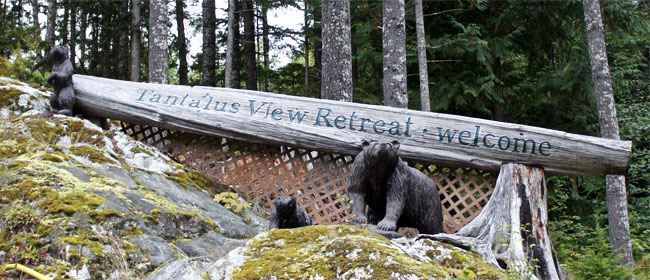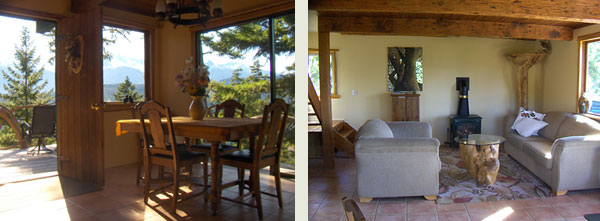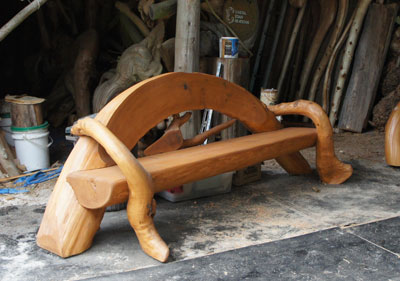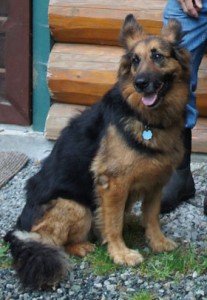Warren met his Janice in British Columbia (BC) Canada in the early 70s. The couple left the province some time later, raising their family in Warren’s homeland of Nova Scotia. They spent years honing their skills in organic gardening, horse logging, log home building and creative self-sufficiency.
Those ‘back-to-the-land’ skills and love of the great outdoors, brought Warren and Janice back home to the West Coast of British Columbia where they proceeded to fall in love with 3 acres of land in the bush, off the Sea to Sky highway near Whistler/Blackcomb. The property wasn’t developed but did have an old shack on it.
Warren and Janice had a vision for this land and inquired about the property but were disappointed when they found that the owners were not interesting in selling. The news didn’t deter the couple, they hoped that one day it would come up for sale and they were willing to wait.
The day finally came. Janice was walking past a realtors office in downtown Squamish and watched a realtor put a picture up of an old shack in the bush. Janice recognized the picture and called Warren immediately.
Warren who was working in Whistler at the time and told Janet:
Grab that realtor, I will meet you as soon as your get him to the bottom of the road. Give me a call when you are heading there and I’ll leave right now. We’ll take her up there and get some papers signed.
There were 15 people in line and fortunately Warren and Janice were the first to get papers together. Although, they went through some financing hoops; the banks didn’t like the idea that the property wasn’t developed; they were eventually able to purchase the property.
Tantalus View Retreat
Warren had experience as a log home builder and this came in handy when the couple built their dream home. They called their home Tantalus View Retreat , naming it for the view of Tantalus mountain. The area is cited as the most spectacular view of all Sea-to-Sky hideaway visits in Canada.
The only original structure on the lot is the guest chalet, and even that was just a dilapidated cabin when they bought it in 1996.
The floorboards were so loose you had to be careful you didn’t sit too heavily on the living room couch or you might launch someone off the porch.
The couple was able to use their skills to make this home a warm and inviting retreat that visitors enjoy when they want to get away from it all…
Powering the Property
The home was originally power with a 3,200 watt generator for several years but he knew that a creek on the property had potential as a power source.
The appropriately named Swift Creek, runs through the property and gets its flow from an underground source. This creek eventually supplied: “the most ideal micro hydro situation you could have” and powers the home and rental chalet.
Before installing the micro hydro system, Warren attended a micro hydro course where he learned is that was really important to have the training under your belt and to help put the system in so you can understand and maintain the system yourself.
He was able to set up his micro hydro system with the help of Peter of www.homepower.ca. Warren totes Peter as a perfect partner. He says Peter was great because he does this with a passion and is more than an installer, he became a friend and he was really good to work with.
Warren’s system includes:
- Turbine: Bronze Turgo Runner® on a custom base
- Generator: Brushless 80 amp heavy-duty alternator
- Operating Head (the vertical distance between the intake and turbine): 86 feet gross, 80 net (pressure available at the turbine from flowing water)
- Rated flow (how much water comes down the stream): 250 gpm (gallons per minute)
- Output: 29 amps at 27 volts nominal, or 780 watts
- Inverter: Trace Series 3624
- Battery bank
Warren’s system covers a double duty as he has it hooked up for a fire hose where he can shut off the turbine and open up with full pressure for fire fighting. The stream also has enough flow to run a sprinkler system while keeping the power running.
How the System Works
Water is diverted from the top of Swift Creek into a an intake pool where Warren has his 2 filter tanks that filter debris out of the water. Warren filters the water with two tanks and added the second one when he found that he was having to clean the single tank too often. The heavier debris ends up in the bottom of the first and the second allows a finer filter screen.
 This then runs into a 4″ pipe (this can be larger or smaller depending on flow) and is directed downhill (Warren has a vertical drop of 86 feet – the drop is called head) creating pressure at the bottom end of the pipe. This then enters his turbine which is driven by the force. The turbine spins a generator and electricity is produced.
This then runs into a 4″ pipe (this can be larger or smaller depending on flow) and is directed downhill (Warren has a vertical drop of 86 feet – the drop is called head) creating pressure at the bottom end of the pipe. This then enters his turbine which is driven by the force. The turbine spins a generator and electricity is produced.
The generated power is stored in Warren’s battery bank. Power coming out of the batteries is in the form of a DC* which further gets converted to AC** power by Warrens inverter, then connects to an ordinary AC breaker panel.
*DC power: direct current – always flows in the same direction. Most common power type produced by fuel cells, batteries and generators.
**AC power: alternating current – flows one way, then the other, continually reversing direction. Most common power in our homes and offices.
Simple Maintenance Required
Maintenance on a micro hydro system – if designed properly, is incredibly small. In a rainforest region such as Warren’s, the fall is the busiest time as falling leaves clog up the filters. During the rainy season maintenance is minor, as you have to periodically check that there is no debris.
We noted that water was spewing out of the pipe and Warren says this simple trick ensures there is not an air lock. When water runs down a mountain you have to keep the line as straight as possible. This creates friction that causes air which builds up in the line. To fix this Warren created an automatic air release by putting a quarter-inch hole at the top of the pipe. Air wants to go to the highest point and is released through the hole.
Battery Bank
The power is stored in a 24 volt battery bank; 8 deep cycle, golf cart type batteries, of 6 volts each.
Warren says
I never draw my batteries down more than 10 percent. Everyone thinks a deep cycle battery needs to be run down fully but they don’t. Any battery likes to be used perfectly. I live with a 24 volt system and that allows me to put a heavy load on it.
One of the potential problems with a 24 volt system is that you need ways to dump the excess energy. Peter invented a duct system to dump this energy. Warren notes that if the light is green, the batteries are happy. If he didn’t have a dumping system the batteries would overload and “cook”.
Making your Batteries Last
Warren’s batteries are lead acid and need to be topped with water from time to time. But Warren also says his batteries will last longer than most because he de-sulfates them once a month.
You can clean the batteries by forcing an extra high voltage into them. Once a month I shut down all loads to both houses and I set my controller to equalize. This forces the batteries into a high voltage and holds it there for 2 hours, melting the sulfates that build up on the battery plates. If you do that on a regular basis your batteries should last a lot longer.
Conservation is the Key
While the micro hydro powers the home and rental, winter heating is supplemented with propane. A wood stove helps to heat the main lodge and a propane powered stove heats the chalet. Cooking is by gas ranges in both lodges.
Warren’s makes sure his guests know that conservation is the key to off-grid living. He asks that they don’t have lights on when they are not in use or that guests don’t run more than one heavy load at a time. This means they can run a hair dryer, tv or toaster but not all at the same time.
Coastal Cedar Creations
Along with running the Tantalus View Retreat, Warren spends time working with wood in his company Coastal Cedar Creations. Here he takes gnarly wood and makes them into benches, arches and other pieces of art.
He says nature knows many ways to introduce a twist into the life of a tree. The stories are all in the wood and Warren preserves those tales by incorporating these timbers into flowing designs.
Respect Nature and It Pays you Back
“It’s all, by living it, you become inventive and there are a lot of little unique tricks. Living off grid you have to work with nature, not against it. Mankind lives against nature. It is in our genes to fight nature. In the history of logging the reason there was so much destruction was because they were afraid of the forest. If it was open they could see their enemies or animals they feared.
Warren says that his system is best for mountainous regions and f you want to be totally environmentally friendly with a system you want to take water from the stream and deliver it back to the stream. Not dump it as some people do.
He also has a great love and respect for nature and closes with the phrase: Respect nature and it pays you back many times.
Sadly, Warren lost his wife Janice prior to our visit, but he still runs the chalet with the help of his friend and companion German Shepherd and Tantalus concierge ‘Bella’ who meets and greets all the guests. Eco friends Terry and Mark were able to see Janice’s touch everywhere, in the beauty of this awe-inspiring and impressive homestead and the gardens surrounding it.













Thank you. That is quite a compliment. If you do visit the area it is sooo beautiful. You will love it.
Cheers, Your ECO Friend Terry
A Brilliant piece on renewable energy! Inspiring & re-assurring that with diligence we don’t have to live through the ransom of dependancy on energy companies. I was sorry hear of the loss of Warren’s partner! What a great & enduring legacy to leave & a nice excuse to visit Canada BC someday. Many thanks, kind regards.